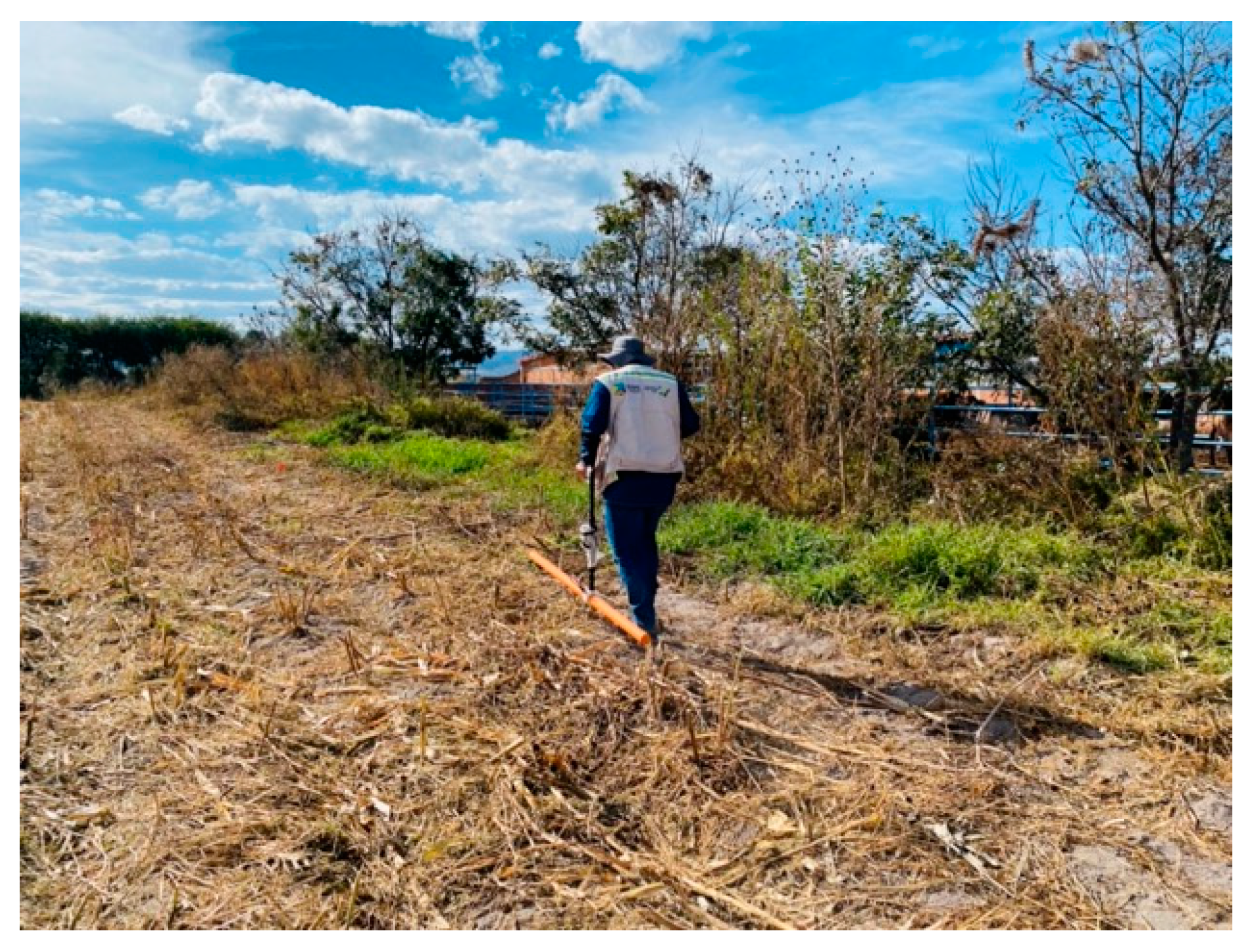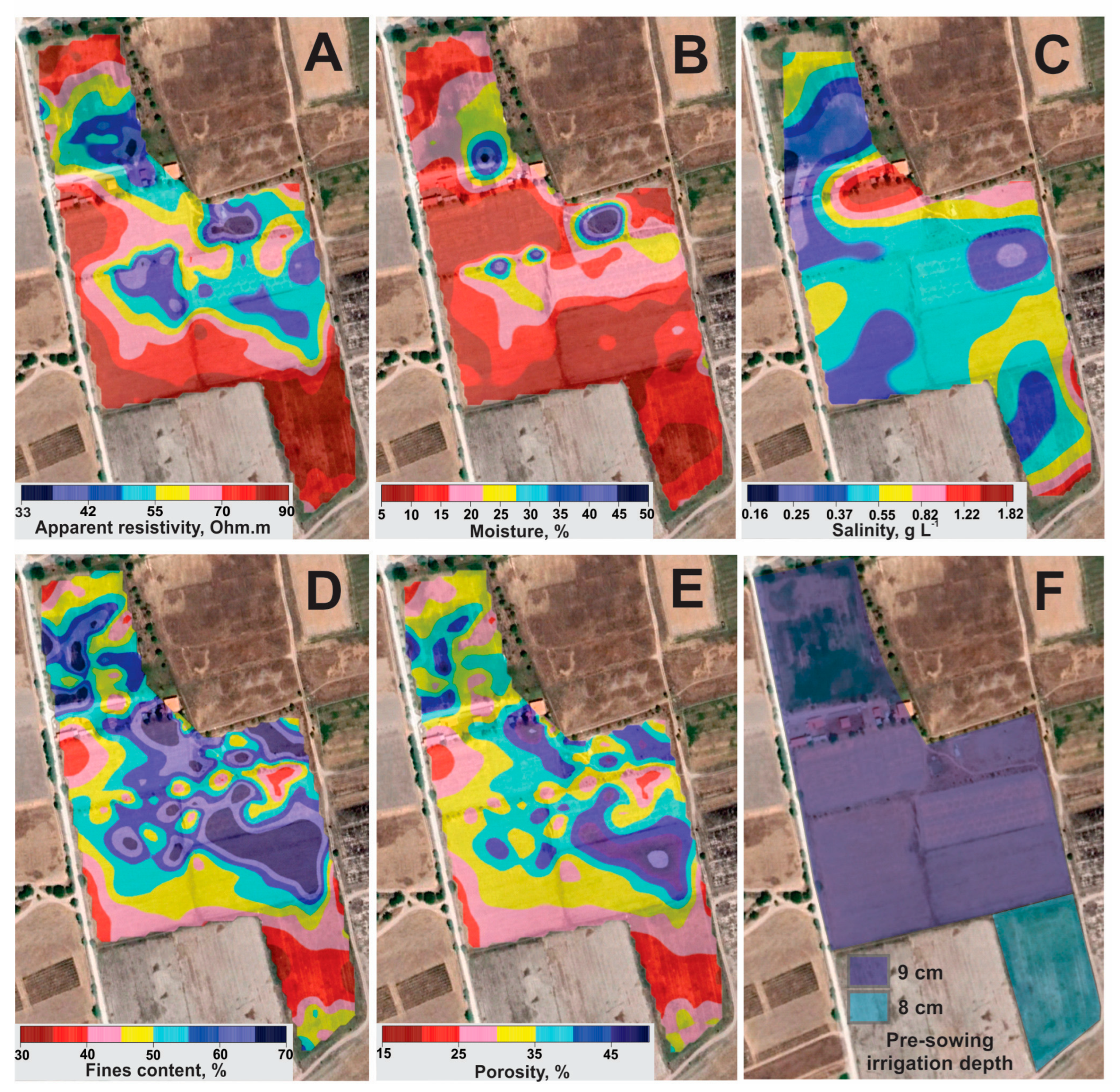Determination of Soil Physical Properties and Pre-Sowing Irrigation Depth from Electrical Resistivity, Moisture, and Salinity Measurements
Abstract
1. Introduction
2. Materials and Methods
2.1. Study Site
2.2. Measurement of Soil Electrical Resistivity
2.3. Measurement of Soil Moisture and Salinity
2.4. Determination of Soil Physical Properties from Electrical Measurements Using the Ryjov´s Soil Model
2.5. Calculation of the Pre-Sowing Irrigation Depth (PSID)
3. Results
3.1. ERT-EMP Results
3.2. Apparent Resistivity, Moisture, and Salinity Maps
3.3. Fines Content and Porosity Maps
3.4. Pre-Sowing Irrigation Depth (PSID)
4. Discussion
5. Conclusions
Author Contributions
Funding
Data Availability Statement
Acknowledgments
Conflicts of Interest
References
- Work Bank Group. World Development Report 2021: Data for Better Lives; World Bank Publications: Washington, DC, USA, 2021. [Google Scholar] [CrossRef]
- González-Trinidad, J.; Júnez-Ferreira, H.E.; Bautista-Capetillo, C.; Ávila Dávila, L. Robles Rovelo CO Improving the Water-Use Efficiency and the Agricultural Productivity: An Application Case in a Modernized Semiarid Region in North-Central Mexico. Sustainability 2020, 12, 8122. [Google Scholar] [CrossRef]
- Kitchen, N.R.; Clay, S.A. Understanding and Identifying Variability. In Precision Agriculture Basics; Kent, S., Clay, D.E., Kitchen, N.R., Eds.; Book Series: ASA, CSSA, and SSSA Books; American Society of Agronomy, Crop Science Society of America, and Soil Science Society of America: Madison, WI, USA, 2018; Chapter 2; pp. 13–24. [Google Scholar] [CrossRef]
- Wang, J.; Ding, J.; Yu, D.; Ma, X.; Zhang, Z.; Ge, X.; Teng, D.; Li, X.; Liang, J.; Lizaga, I.; et al. Capability of Sentinel-2 MSI data for monitoring and mapping of soil salinity in dry and wet seasons in the Ebinur Lake region, Xinjiang, China. Geoderma 2019, 353, 172–187. [Google Scholar] [CrossRef]
- Lu, F.; Sun, Y.; Hou, F. Using. UAV visible images to estimate the soil moisture of steppe. Water 2020, 12, 2334. [Google Scholar] [CrossRef]
- Zhuang, R.; Zeng, Y.; Manfreda, S.; Su, Z. Quantifying Long-Term Land Surface and Root Zone Soil Moisture over Tibetan Plateau. Remote Sens. 2020, 12, 509. [Google Scholar] [CrossRef]
- Bertalan, L.; Holb, I.; Pataki, A.; Négyesi, G.; Szabó, G.; Szalóki, A.K.; Szabó, S. UAV-based multispectral and thermal cameras to predict soil water content–A machine learning approach. Comput. Electron. Agric. 2022, 200, 107262. [Google Scholar] [CrossRef]
- Celik, M.F.; Isik, M.S.; Yuzugullu, O.; Fajraoui, N.; Erten, E. Soil Moisture Prediction from Remote Sensing Images Coupled with Climate, Soil Texture and Topography via Deep Learning. Remote Sens. 2022, 14, 5584. [Google Scholar] [CrossRef]
- Robert, P.C. Precision agriculture: A challenge for crop nutrition management. Plant Soil 2002, 247, 143–149. [Google Scholar] [CrossRef]
- Zhang, N.; Wang, M.; Wang, N. Precision agriculture-A worldwide overview. Comput. Electron. Agric. 2002, 36, 113–132. [Google Scholar] [CrossRef]
- Bitella, G.; Rossi, R.; Loperte, A.; Satriani, A.; Lapenna, V.; Perniola, M.; Amato, M. Geophysical Techniques for Plant, Soil, and Root Research Related to Sustainability. In The Sustainability of Agro-Food and Natural Resource Systems in the Mediterranean Basin; Vastola, A., Ed.; Springer: Cham, Switzerland, 2015. [Google Scholar] [CrossRef]
- Romero-Ruiz, A.; Linde, N.; Keller, T.; Or, D. A review of geophysical methods for soil structure characterization. Rev. Geophys. 2019, 56, 672–697. [Google Scholar] [CrossRef]
- Corwin, D.L.; Lesch, S.M. Application of soil electrical conductivity to precision agriculture. Agron. J. 2003, 95, 455–471. [Google Scholar] [CrossRef]
- Allred, B.J.; Freeland, R.S.; Farahani, H.J.; Collins, M.E. Agricultural Geophysics: Past, Present, and Future. In 23rd EEGS Symposium on the Application of Geophysics to Engineering and Environmental Problems; European Association of Geoscientists & Engineers: Las Vegas, NV, USA, 2010. [Google Scholar] [CrossRef]
- Algeo, J.; Van Dam, R.L.; Slater, L. Early-time GPR: A method to monitor spatial variations in soil water content during irrigation in clay soils. Vadose Zone J. 2016, 15, 1–9. [Google Scholar] [CrossRef]
- Vories, E.; O’Shaughnessy, S.; Sudduth, K.; Evett, S.; Andrade, M.; Drummond, S. Comparison of precision and conventional irrigation management of cotton and impact of soil texture. Precis. Agric. 2021, 22, 414–431. [Google Scholar] [CrossRef]
- Garré, S.; Hyndman, D.; Mary, B.; Werban, U. Geophysics conquering new territories: The rise of “agrogeophysics”. Vadose Zone J. 2021, 20, e20115. [Google Scholar] [CrossRef]
- Tso, C.-H.M.; Kuras, O.; Binley, A. On the field estimation of moisture content using electrical geophysics: The impact of petrophysical model uncertainty. Water Resour. Res. 2019, 55, 7196–7211. [Google Scholar] [CrossRef]
- Ozegin, K.O.; Salufu, S.O. Electrical Geophysical method and GIS in Agricultural Crop Productivity in a Typical Sedimentary Environment. NRIAG J. Astron. Geophys. 2022, 11, 69–80. [Google Scholar] [CrossRef]
- Ryjov, A.; Shevnin, V. Theoretical calculation of rocks electrical resistivity and some examples of algorithm’s application. In Proceedings of the 15th EEGS Symposium on the Application of Geophysics to Engineering and Environmental Problems, Las Vegas, NV, USA, 10–14 February 2002; EAGE: Las Vegas, NV, USA, 2002. [Google Scholar] [CrossRef]
- Delgado-Rodríguez, O.; Shevnin, V.; Peinado-Guevara, H.; Ladrón-de-Guevara-Torres, M.A. Characterization of Hydrocarbon-Contaminated Sites Based on Geoelectrical Methods of Geophysical Exploration. In Book Geophysics; Okiwelu, A., Ed.; InTechOpen: London, UK, 2018; Chapter 5; pp. 85–93. [Google Scholar] [CrossRef]
- Shevnin, V.; Delgado-Rodríguez, O.; Mousatov, A.; Ryjov, A. Soil resistivity measurements for clay content estimation and its application for petroleum contamination study. In Proceedings of the 17th EEGS Symposium on the Application of Geophysics to Engineering and Environmental Problems, Colorado Springs, CO, USA, 22–26 February 2004; EAGE: Colorado Springs, CO, USA, 2004; pp. 396–408. [Google Scholar]
- Shevnin, V.; Delgado-Rodríguez, O.; Mousatov, A.; Flores-Hernández, D.; Zegarra-Martínez, H.; Ryjov, A. Estimation of soil petrophysical parameters from resistivity data: Application to oil-contaminated site characterization. Geofis. Int. 2006, 45, 179–193. [Google Scholar] [CrossRef]
- Shevnin, V.; Delgado-Rodríguez, O.; Mousatov, A.; Ryjov, A. Estimation of hydraulic conductivity on clay content in soil determined from resistivity data. Geofis. Int. 2006, 45, 195–207. [Google Scholar] [CrossRef]
- Shevnin, V.; Mousatov, A.; Ryjov, A.; Delgado-Rodríguez, O. Estimation of clay content in soil based on resistivity modeling and laboratory measurements. Geophys. Prospect. 2007, 55, 265–275. [Google Scholar] [CrossRef]
- Delgado-Rodríguez, O.; Ladrón-de-Guevara-Torres, M.A.; Shevnin, V.; Ryjov, A. Estimation of soil petrophysical parameters based on electrical resistivity values obtained from lab and in-field measurements. Geofis. Int. 2012, 51, 5–15. [Google Scholar] [CrossRef]
- Gastélum-Contreras, A.K.; Espinoza-Ortiz, M.; Peinado-Guevara, H.J.; Delgado-Rodríguez, O.; Ladrón de Guevara, M.; Peinado-Guevara, V.M. Using electrical profiling to determine soil petrophysical parameters in an agricultural field. Pol. J. Environ. Stud. 2017, 26, 1077–1087. [Google Scholar] [CrossRef]
- Cordero-Vázquez, C.Y.; Delgado-Rodríguez, O.; Peinado-Guevara, H.J.; Ladrón-de-Guevara-Torres, M.; Hernández-Ramos, J.O.; Peinado-Guevara, V.M. Determination of soil properties from electrical measurements in agricultural plots, Villa de Arriaga, San Luis Potosí, Mexico. Geofis. Int. 2021, 60, 76–100. [Google Scholar] [CrossRef]
- INEGI. Summary on Municipal Geographic Information of the United Mexican States: San Felipe, Guanajuato; Instituto Nacional de Estadística y Geografía: Guanajuato, Mexico, 2009; Available online: https://docplayer.es/38475767-Prontuario-de-informacion-geografica-municipal-de-los-estados-unidos-mexicanos-san-felipe-del-progreso-mexico-clave-geoestadistica-15074.html (accessed on 10 February 2023).
- McNeill. Electromagnetic terrain conductivity measurements at low induction numbers. In Technical Note TN-6; Geonics Limited: Mississauga, ON, Canada, 1980; Available online: http://www.geonics.com/pdfs/technicalnotes/tn6.pdf (accessed on 25 January 2023).
- Gf Instruments, S.R.O. Electromagnetic Conductivity Meters for Multi-Layer Survey. 2020. Available online: http://www.gfinstruments.cz/version_cz/downloads/CMD_2020.pdf (accessed on 25 January 2023).
- Kearey, P.; Brooks, M.; Hill, I. An Introduction to Geophysical Exploration, 3rd ed.; Blackwell Science Ltd.: Hoboken, NJ, USA, 2002. [Google Scholar]
- Loke, M.H.; Barker, R.D. Rapid least-squares inversion of apparent resistivity pseudosections using a quasi-Newton method. Geophys. Prospect. 1996, 44, 131–152. [Google Scholar] [CrossRef]
- Saxton, K.E.; Rawls, W.J.; Romberger, J.S.; Papendick, R.I. Estimating generalized soil-water characteristics from texture. Soil Sci. Soc. Am. J. 1986, 50, 1031–1036. [Google Scholar] [CrossRef]
- Silva, A.; Ponce de León, J.; García, F.; Artigas, D. Methodological aspects in the determination of the water holding capacity of soils in Uruguay. In Boletín de Investigación 10; Facultad de Agronomía, Universidad de la República: Montevideo, Uruguay, 1988; Available online: https://www.colibri.udelar.edu.uy/jspui/bitstream/20.500.12008/31373/1/boletin_de_investigacion_1988_10.pdf (accessed on 10 February 2023).
- Chaudhari, P.R.; Ahire, D.V.; Ahire, V.D.; Chkravarty, M.; Maity, S. Soil bulk density as related to soil texture, organic matter content and available total nutrients of coimbatore soil. IJSRP 2013, 3, 1–8. Available online: https://www.ijsrp.org/research-paper-0213/ijsrp-p1439.pdf (accessed on 13 February 2023).
- Lestariningsih, I.D.; Widianto Hairiah, K. Assessing Soil Compaction with Two Different Methods of Soil Bulk Density Measurement in Oil Palm Plantation Soil. Procedia Environ. Sci. 2013, 17, 172–178. [Google Scholar] [CrossRef]
- Brogowski, Z.; Kwasowski, W.; Madyniak, R. Calculating particle density, bulk density, and total porosity of soil based on its textura. Soil Sci. Ann. 2014, 65, 139–149. [Google Scholar] [CrossRef]
- Richards, L.A. Diagnosis and improvement of saline and alkali soils. In United States Department of Agriculture. Agriculture Handbook 60; U.S. Government Printing Office: Washington, DC, USA, 1954. Available online: https://www.ars.usda.gov/ARSUserFiles/20360500/hb60_pdf/hb60complete.pdf (accessed on 12 February 2023).
- Quimbita, W.; Toapaxi, E.; Llanos, J. Smart irrigation system considering optimal energy management based on model predictive control (MPC). Appl. Sci. 2022, 12, 4235. [Google Scholar] [CrossRef]





| Depth VP/Depth HP | S |
|---|---|
| 0.30/0.15 m | 0.20 m |
| 0.50/0.25 m | 0.33 m |
| 0.80/0.40 m | 0.50 m |
| 1.10/0.50 m | 0.72 m |
| 1.60/0.80 m | 1.03 m |
| 2.30/1.10 m | 1.50 m |
Disclaimer/Publisher’s Note: The statements, opinions and data contained in all publications are solely those of the individual author(s) and contributor(s) and not of MDPI and/or the editor(s). MDPI and/or the editor(s) disclaim responsibility for any injury to people or property resulting from any ideas, methods, instructions or products referred to in the content. |
© 2023 by the authors. Licensee MDPI, Basel, Switzerland. This article is an open access article distributed under the terms and conditions of the Creative Commons Attribution (CC BY) license (https://creativecommons.org/licenses/by/4.0/).
Share and Cite
Cordero-Vázquez, C.Y.; Delgado-Rodríguez, O.; Cisneros-Almazán, R.; Peinado-Guevara, H.J. Determination of Soil Physical Properties and Pre-Sowing Irrigation Depth from Electrical Resistivity, Moisture, and Salinity Measurements. Land 2023, 12, 877. https://doi.org/10.3390/land12040877
Cordero-Vázquez CY, Delgado-Rodríguez O, Cisneros-Almazán R, Peinado-Guevara HJ. Determination of Soil Physical Properties and Pre-Sowing Irrigation Depth from Electrical Resistivity, Moisture, and Salinity Measurements. Land. 2023; 12(4):877. https://doi.org/10.3390/land12040877
Chicago/Turabian StyleCordero-Vázquez, Christian Y., Omar Delgado-Rodríguez, Rodolfo Cisneros-Almazán, and Héctor J. Peinado-Guevara. 2023. "Determination of Soil Physical Properties and Pre-Sowing Irrigation Depth from Electrical Resistivity, Moisture, and Salinity Measurements" Land 12, no. 4: 877. https://doi.org/10.3390/land12040877
APA StyleCordero-Vázquez, C. Y., Delgado-Rodríguez, O., Cisneros-Almazán, R., & Peinado-Guevara, H. J. (2023). Determination of Soil Physical Properties and Pre-Sowing Irrigation Depth from Electrical Resistivity, Moisture, and Salinity Measurements. Land, 12(4), 877. https://doi.org/10.3390/land12040877










